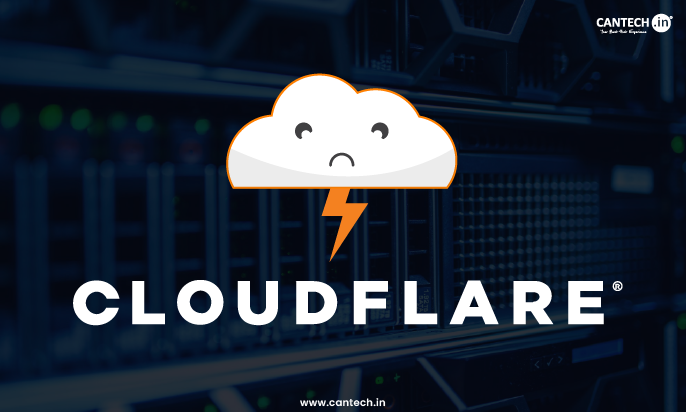Cloudflare Outage Takes Down Crucial Apps
After a massive outage, hundreds of sites such as Chatgpt, OpenAI, Twitter (X), Spotify, Canva, Claude, and other large platforms went down on Nov 18, 2025 after a major technical failure that impacted Cloudflare- the primary IT infrastructure and security notifier to many high-traffic online sources. The scale of the incident was so large that even Downdetector, a service tracking outages, was affected by the same technical issues and went offline before returning to service and recording a sharp increase in user reports across the entire globe. Here is all you need to know:
What is Cloudflare?
Cloudflare is a major and a critical internet infrastructure and security firm that provides services to millions of websites and internet applications across the globe. By layman language, it is a critical middleware between the user and the host server of a web site and is therefore a critical middle layer. Therefore, in case Cloudflare suffers a significant technical issue, it does not only interfere with its services but also prevents access to a huge amount of sites relying on it.
To know more about Cloudflare read our in depth blog on what is Cloudflare
What is the Service Offering of Cloudflare?
Cloudflare is a provider of one of the largest content delivery networks (CDNs) in the world. It offers a number of key functions which are almost indispensable to most significant modern websites:
- Content Delivery Network (CDN): Can Cloudflare host replicas of website content in its global network of servers? Upon a request of a site, the information is delivered by the nearest Cloudflare server, which leads to a shorter loading time.
- DDoS defense: Cloudflare is a firewall that secures sites against a distributed denial-of-service (DDoS) attacks, in which the attacker floods a site with unmanaged traffic.
- Security and firewalls – The service is provided with web application firewalls and security filters which block malicious traffic before the original server of the site receives the request.
- DNS services: Cloudflare is the operator of the complicated phone book of the internet, which is used to redirect traffic to the appropriate IP addresses.
What Caused the Cloudflare Outage?
The websites that had outages (X, Spotify, etc.) themselves weren’t facing issues with their servers; the issue was happening at the Cloudflare layer that sits in front of them. When something went wrong with Cloudflare’s network – an internal error – it had a domino effect.
Although each outage varies, common causes include:
-
Network configuration bugs
-
Propagation issues in global data centers
-
Software deployment errors
-
Load-balancing misbehavior
-
Bot management rule conflicts
These systems operate at global scale, so a small misalignment can trigger widespread disruption.
Services Impacted During the Outage
The outage affected multiple sectors, including:
-
Websites relying on Cloudflare CDN
-
APIs and backend systems
-
SaaS platforms
-
E-commerce websites
-
Banking and fintech applications
-
Developer platforms using Cloudflare Workers
-
Apps relying on Cloudflare DNS
Users reported slow loading, complete downtime, or intermittent accessibility.
Many also encountered recurring 500 errors and gateway timeouts, reflecting widespread instability across Cloudflare’s network:

Impact on Businesses and Users
The outage had several implications:
1. Downtime Losses
Businesses relying heavily on CDN and DNS experienced financial impact during the downtime window.
2. Service Disruptions
Users faced 500 errors, login issues, failed transactions, and API breakdowns.
3. Security Alerts
Some monitoring tools falsely flagged outages as attacks due to unusual traffic patterns.
4. Supply Chain Effect
Services integrated with Cloudflare indirectly impacted other platforms.
What Cloudflare Said About the Outage
Cloudflare yesterday confirmed the incidents experienced by its clients and says it has launched an investigation immediately. In its latest update, it says it is “working on restoring service for application services customers. We’ve made changes that have enabled Cloudflare Access and WARP to recover. Error levels for Access and WARP users have returned to pre-incident rates. We’ve re-enabled WARP access in London,” Cloudflare claimed in a prior update. “During our attempts to remediate, we have disabled WARP access in London.
As per the recent updates, Cloudflare has ordered the probe related to IPSec in Magic WAN and Magic Transit products. Sarah Kreps, Cornell University, Director highlights the latest outage reason as the mundane of AI infrastructure.
The Hidden Risk of Relying Entirely on Foreign Cloud Providers
Outages like this highlight a deeper issue: an over-dependence on international infrastructure. When critical digital operations are tied to providers located halfway across the world, any disruption-whether technical, geopolitical, or regulator-can instantly ripple across local businesses. It creates a single point of failure where even a minor configuration error can halt entire digital ecosystems.
For growing economies and digitally active regions, this raises questions about data sovereignty, availability, and long-term resilience. It reinforces the importance of strengthening domestic technology capabilities and building local alternatives that can offer stability closer to home. Providers with regional infrastructure and on-ground engineering expertise, such as homegrown data center and cloud solution companies, play a vital role in reducing this risk. They add a layer of independence, reliability, and control that purely foreign networks simply cannot guarantee.
In the future, adopting a hybrid approach-combining global networks with trusted local infrastructur- may become essential for businesses seeking uninterrupted performance and reduced exposure to global disruptions.
How It Was Fixed?
Once Cloudflare detected elevated error rates across its global network, engineers quickly stopped the propagation of the faulty configuration file that triggered the outage. They restored a previously known-good version of the file and restarted their core proxy services to clear the incorrect state from the system. As the corrected configuration began to propagate across data centers, error rates steadily dropped and services gradually recovered.
Most core traffic stabilized within a few hours, and full service restoration was completed once all network layers returned to normal performance. Following the fix, Cloudflare strengthened validation around feature file ingestion and initiated plans for global kill switches to prevent similar failures from escalating in the future.
Conclusion
Cloudflare’s outage serves as a reminder that even the most advanced internet infrastructure can experience downtime. While the disruption affected millions of users, Cloudflare’s quick response and transparent communication helped restore stability. For businesses, this is an important lesson in resilience, redundancy, and proactive monitoring.
For full details about the incident, see the official post by Cloudflare here.




